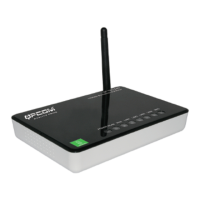The MAC (Media Access Control) address is your computer's unique hardware number. (On
an Ethernet LAN, it's the same as your Ethernet address.) When you're connected to the Inter-
net from your computer (or host as the Internet protocol thinks of it), a correspondence table
relates your IP address to your computer's physical (MAC) address on the LAN.
To find your PC’s IP and MAC address,
• Open the Command program in the Microsoft Windows.
• Type in ipconfig /all then press the Enter button.
• Your PC’s IP address is the one entitled IP Address and your PC’s MAC address
is the one entitled Physical Address.
What is Wireless LAN?
A wireless LAN (WLAN) is a network that allows access to Internet without the need for any
wired connections to the user’s machine.
What are ISM bands?
ISM stands for Industrial, Scientific and Medical; radio frequency bands that the Federal Com-
munications Commission (FCC) authorized for wireless LANs. The ISM bands are located at
915 +/- 13 MHz, 2450 +/- 50 MHz and 5800 +/- 75 MHz.
How does wireless networking work?
The 802.11 standard define two modes: infrastructure mode and ad hoc mode. In infrastructu-
re mode, the wireless network consists of at least one access point connected to the wired
network infrastructure and a set of wireless end stations. This configuration is called a Basic
Service Set (BSS). An Extended Service Set (ESS) is a set of two or more BSSs forming a
single subnetwork. Since most corporate WLANs require access to the wired LAN for services
(file servers, printers, Internet links) they will operate in infrastructure mode.
www.qpcom.com/www.qpcom.com.co
Distribution System (DS)
Basic Service Set (BSS)
Extended Service Set (ESS)
Access Point Access Point

